 SF photographer Sean McFarland‘s Polaroid landscapes are streaked with movement, traced with the remnants of a human or a natural footprint — whether it’s a twister touching down, a small biplane scuttling above the earth or a sentimental starburst of light in an ocean sunset. His night scenes have the otherworldy dislocation of a day-for-night shot. McFarland just won the 2009 Baum Award for Emerging American Photographers.
SF photographer Sean McFarland‘s Polaroid landscapes are streaked with movement, traced with the remnants of a human or a natural footprint — whether it’s a twister touching down, a small biplane scuttling above the earth or a sentimental starburst of light in an ocean sunset. His night scenes have the otherworldy dislocation of a day-for-night shot. McFarland just won the 2009 Baum Award for Emerging American Photographers.
Archive for the ‘Alternative Processes’ Category
Lines in the Sand
Posted in Alternative Processes, Art, Photography on March 31, 2009| Leave a Comment »
Man with a Room-Size Camera
Posted in Alternative Processes, Art, Galleries & Museums, Photography on February 21, 2008| Leave a Comment »
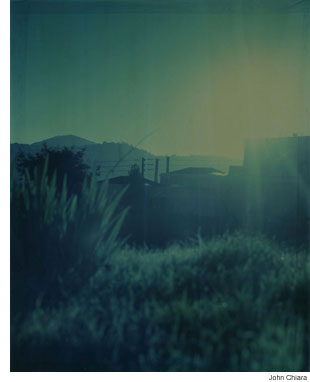 San Francisco-based photographer, John Chiara, works with a lumbering camera he built himself that he carts around with him on the back of a flatbed truck. He creates unique prints by exposing directly onto photographic paper placed on the inside back wall of the camera, using his hand over the lens as a dodge and burn tool. Maneuvering his way in and out of the camera through a long black baffle tube made from heavy plastic tarp, he looks like he’s being consumed by the camera.
San Francisco-based photographer, John Chiara, works with a lumbering camera he built himself that he carts around with him on the back of a flatbed truck. He creates unique prints by exposing directly onto photographic paper placed on the inside back wall of the camera, using his hand over the lens as a dodge and burn tool. Maneuvering his way in and out of the camera through a long black baffle tube made from heavy plastic tarp, he looks like he’s being consumed by the camera.
With his outsize equipment the process is much less science than it is poetic approximation—the lack of exactitude, the larger-than-life apparatus are what make Chiara’s work so singular and theatrical. Picture taking as performance.
Chiara develops his prints in a large tube created specifically for this purpose that he fills with chemistry and rolls across his studio floor. His photos have the hazy, otherworldly look of early landscape photography. Chiara calls his images “visual memories,” objects that “reference apparition and memory.”
KQED television’s art program, “Spark,” did a great interview with Chiara that walks through the shooting and developing process with him. His work is on display at Von Lintel Gallery in New York.
Gender Play
Posted in Alternative Processes, Art, Photography, Vernacular/Found Photography on January 6, 2008| Leave a Comment »
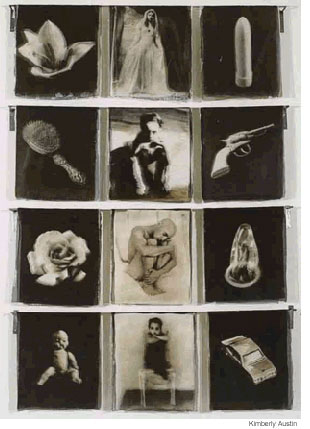 Kimberly Austin‘s images waver and blur on silk and muslin banners. Her technique involves developing the same image on two different swaths of textile, using two distinct alternative processes. She prints one sheet of fabric using cyanotype and the other using Van Dyke then hangs both layers of material over a metal rod so that the Prussian blue of cyanotype and the rusty brown of Van Dyke line up, creating an inky image.
Kimberly Austin‘s images waver and blur on silk and muslin banners. Her technique involves developing the same image on two different swaths of textile, using two distinct alternative processes. She prints one sheet of fabric using cyanotype and the other using Van Dyke then hangs both layers of material over a metal rod so that the Prussian blue of cyanotype and the rusty brown of Van Dyke line up, creating an inky image.
This piece, “Contra Natura,” organizes images of people and things like numbers on a bingo card or reels on a slot machine, insinuating a sense of blind luck, of random and multiple arrangements. A boy ends up between an antique brush and a gun, a child seated on a chair is flanked by a baby doll and a toy car. Domestic beauty on the left, force and speed on the right and in between a person.
Austin’s choice of images and groupings, forces us into stereotypical assumptions about gender, but the grid-like structure also allows the viewer to imagine rearranging these objects to come up with a different pattern.
Grey Area
Posted in Alternative Processes, Art, Photography on January 4, 2008| Leave a Comment »
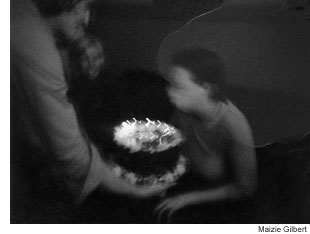 Maizie Gilbert compares looking at her photos to “watching a movie in a foreign language without subtitles.” Forget about the words just follow the pictures and try to extract fleeting threads of a storyline. Gilbert shoots color and b&w with a 1970s Polaroid land camera, using the lo-tech device to snap dreamy film frames. A box of Krispy Kremes. An empty double bed, neatly made. The blur of people passing in a hallway. Her work has a fuzzy, out-of-focus quality reminiscent of cast-off, throwaway snapshots, the ones where someone moves, or the light is too low—the ones that most people don’t want to keep. Gilbert’s images come to life not in the “decisive moment,” but in the vague, fluid instant just before or just after.
Maizie Gilbert compares looking at her photos to “watching a movie in a foreign language without subtitles.” Forget about the words just follow the pictures and try to extract fleeting threads of a storyline. Gilbert shoots color and b&w with a 1970s Polaroid land camera, using the lo-tech device to snap dreamy film frames. A box of Krispy Kremes. An empty double bed, neatly made. The blur of people passing in a hallway. Her work has a fuzzy, out-of-focus quality reminiscent of cast-off, throwaway snapshots, the ones where someone moves, or the light is too low—the ones that most people don’t want to keep. Gilbert’s images come to life not in the “decisive moment,” but in the vague, fluid instant just before or just after.
An Hungarian in Paris
Posted in Alternative Processes, Art, France, Galleries & Museums, Photography on November 30, 2007| Leave a Comment »
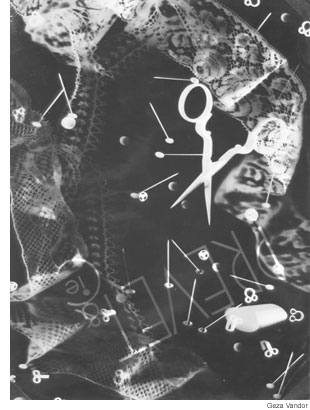 I went to the preview for SF Camerawork’s annual benefit auction last night. Lots of good contemporary work along with a smattering of older pieces.
I went to the preview for SF Camerawork’s annual benefit auction last night. Lots of good contemporary work along with a smattering of older pieces.
One of the vintage images that jumped out at me was Geza Vandor‘s “Scissors and Lace” (c. 1930) which shows a photogram jumble of sewing notions.
Born in Hungary in the late 19th century, Vandor started as a filmmaker in Budapest, then moved to Paris in 1921. He took up still photography a few years later and began showing with the likes of Kertesz, Man Ray, Brassai, Florence Henri. His images reflect his background: the intense shadow and angle of Soviet Constructivism and the odd and mysterious juxtapositions of Surrealism.
I particularly like his images of a solarized Christmas tree, a photogram of a man stubbing out a cigarette and this haunting image of a car driving down a tree-lined road at night.
Remains of the Day (or Week or Month)
Posted in Alternative Processes, Art, News & Magazines, Photography, Pinhole Photography on September 29, 2007| Leave a Comment »
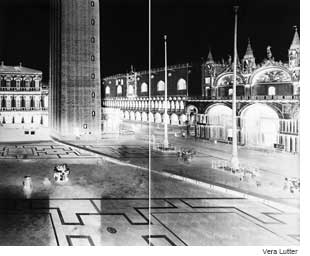 Artkrush decorated their last newsletter with German photographer Vera Lutter‘s camera obscura image of San Marco. The picture has all the inverted elegance of a film negative with its shadows that gleam and bright sunlight that turns black. But Lutter’s images are about more than just light and dark. Standard photographs are instantaneous; Lutter‘s are taken over days, even months, which introduces time and space as new elements.
Artkrush decorated their last newsletter with German photographer Vera Lutter‘s camera obscura image of San Marco. The picture has all the inverted elegance of a film negative with its shadows that gleam and bright sunlight that turns black. But Lutter’s images are about more than just light and dark. Standard photographs are instantaneous; Lutter‘s are taken over days, even months, which introduces time and space as new elements.
There are no passersby in Lutter’s photos, just buildings, ghost towns. Architecture and landscape persist, sit long and hard, burn shadows, while people pass through without a trace—although she admits in a great interview with BOMB Magazine that a tenacious sunbather made an imprint in one of her shorter exposures.
Lutter’s prints are large, often wall size. One of her cameras was actually a shipping container. She talks about sitting in the camera at one point, watching the image projected on the wall: “The fast movements don’t stay in the photograph, but I see the cars driving through the image, I see trains, boats going by, birds and airplanes flying through. It’s like watching a film, but the image is reversed, upside down, and very crisp.” In some ways, her images resemble the theater photographs of Sugimoto where an entire movie over the period of a few hours leaves nothing but a glowing white screen.
Going Against the Grain
Posted in Alternative Processes, Art, Photography on July 31, 2007| Leave a Comment »
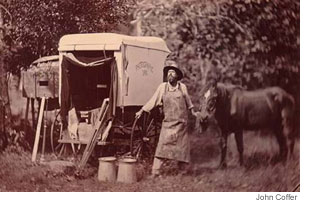 The New York Times profiled tintype photographer John Coffer in an article illustrated with Coffer’s own tintype self-portraits and accompanied by a multimedia piece in which Coffer speaks about his life and work. As a boy, Coffer became fascinated with a tintype of his great great grandfather and later decided he wanted to learn the technique. He began photographing civil war reenactments and has since moved on to become a respected teacher of the craft.
The New York Times profiled tintype photographer John Coffer in an article illustrated with Coffer’s own tintype self-portraits and accompanied by a multimedia piece in which Coffer speaks about his life and work. As a boy, Coffer became fascinated with a tintype of his great great grandfather and later decided he wanted to learn the technique. He began photographing civil war reenactments and has since moved on to become a respected teacher of the craft.
What makes Coffer’s story so interesting, at least for me, is the fact that his craft is deeply tied up in his lifestyle—the romance with an antique process led him to experiment with an antique lifestyle in which he lives much like people did in the mid 1800s. He lives off the grid with no running water and a minimal supply of solar electricity. He uses a horse and buggy rather than a car, built his own house and raises much of his food. Some small concessions to the 21st century come in the form of a computer (with no Internet connection) and a small radio to listen to NPR. The intimate details of how he has become completely self-sufficient bring out the voyeur in me, but I don’t think most of us would want to go to his extremes. He is an anachronism separated from the contemporary world in many ways, a curious specimen in a bell jar.
Paris Photo
Posted in Alternative Processes, Art, France, Galleries & Museums, Photography on July 29, 2007| Leave a Comment »
Visited this little gallery/bookstore called Chez Higgins during my vacation in Paris this June. After walking through a very dark courtyard on rue de l’Ancienne Comedie, I stepped into a brightly lit room with no windows, only glass-covered cabinets full of books lining all the walls. The owner, Eric Higgins, creates limited edition photographic portfolios. Each volume has a suede cover with slipcase and contains approximately fifteen 5″ x 7″ silver gelatin prints nestled between transparent paper. Higgins’ goal is to make quality black and white prints both affordable and collectible.
I bought a copy of Detroit photographer Sue Rynski’s portfolio called “End of the Night” for my boyfriend, Mark. The collection features black and white photos of the Motor City punk scene in the late 70s with a preface by Iggy Pop. While I was waiting for M. Higgins to wrap up the portfolio he explained how the rock star royal had stopped in the day before to pick up his copy.
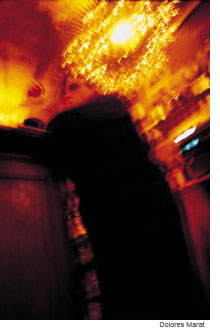 Higgins has also produced a portfolio of Dolores Marat’s color pieces. While I was in Paris, her work was showing simultaneously at an exhibit at Galerie Kamel Mennour. Marat uses an alternative process created in the early 1900s called the Fresson technique which results in a diffuse, impressionistic image. The negative is broken into four transparencies (CMYK) and is printed four times, each transparency overlaid on the other. The technique suits Marat’s moody shots of Paris and New York. I love this shimmering shot of a woman leaning on le zinc, the bar, cigarette in hand, the lights behind her silhouette exploding in yellow starbursts. Or this lone woman descending the escalator in the metro, bundled in an elegant coat, gloves and handbag, washed in blue, her face not visible.
Higgins has also produced a portfolio of Dolores Marat’s color pieces. While I was in Paris, her work was showing simultaneously at an exhibit at Galerie Kamel Mennour. Marat uses an alternative process created in the early 1900s called the Fresson technique which results in a diffuse, impressionistic image. The negative is broken into four transparencies (CMYK) and is printed four times, each transparency overlaid on the other. The technique suits Marat’s moody shots of Paris and New York. I love this shimmering shot of a woman leaning on le zinc, the bar, cigarette in hand, the lights behind her silhouette exploding in yellow starbursts. Or this lone woman descending the escalator in the metro, bundled in an elegant coat, gloves and handbag, washed in blue, her face not visible.
As a footnote, if you’re going to Paris, check out this page from rendezvousfrance.com that highlights the important photo galleries in Paris. The editors are Cara Ballard and Jean-Sebastien Stehli, an editor at L’Express.
Shake It Like a Polaroid Picture
Posted in Alternative Processes, Art, Galleries & Museums, Photography, Vernacular/Found Photography on July 27, 2007| 1 Comment »
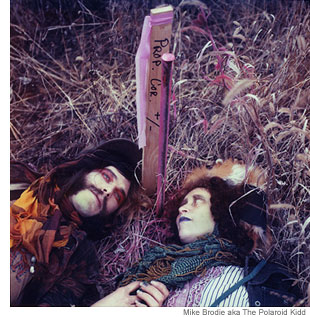 In his photo series, “Ridin’ Dirty Face,” Mike Brodie (aka The Polaroid Kidd) crisscrossed the country riding the rails, capturing raw pictures of young hobos, grimy, tattoed, romantic 21st-century gypsies.
In his photo series, “Ridin’ Dirty Face,” Mike Brodie (aka The Polaroid Kidd) crisscrossed the country riding the rails, capturing raw pictures of young hobos, grimy, tattoed, romantic 21st-century gypsies.
The series also includes candids of the inhabitants of a small seaside town in Maine where a group of runaway middle-class kids live off the grid in their own constructed universe, dressed in cast-off clothes, infiltrating makeshift dwellings and turning them into artful homes.
Like Larry Clark, Brodie immerses himself in the lifestyle so his subjects open up to the camera, disregard it, don’t see it as a voyeuristic intrusion. His work will be on display at Needles & Pens in San Francisco from August 3rd through the 30th.
Another online Polaroid site, PolaNoir sells artist-created high quality Lambda prints of Polaroid originals in limited editions of 47. Each print is 147 Euros. Some of the artists include Filippo Centenari who manipulates the Polaroid surface so it looks like a painting. Or Grant Hamilton‘s minimal abstractions. PolaNoir also has offline galleries in Vienna, Barcelona and Berlin. The owner of the site, who remains anonymous, describes the Polaroid SX-70 as “an instant camera that took the heart of our analogue passion by storm.”
Pinhole Wizard
Posted in Alternative Processes, Art, Books, Galleries & Museums, Photography, Pinhole Photography on July 10, 2007| Leave a Comment »
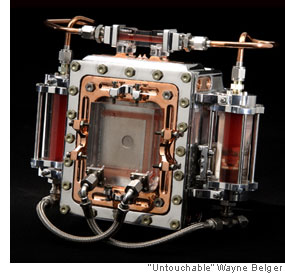 I was rummaging through some papers and came across a flyer for an exhibit I saw a while back at Varnish Gallery. The show was called “A Collection of Souls from the Borderland” and it showcased Wayne Belger‘s pinhole cameras and the photos he takes with them.
I was rummaging through some papers and came across a flyer for an exhibit I saw a while back at Varnish Gallery. The show was called “A Collection of Souls from the Borderland” and it showcased Wayne Belger‘s pinhole cameras and the photos he takes with them.
Belger, an LA-based artist trained originally as a machinist, discovered pinhole cameras when a photographer friend asked him to build one for a project he was doing. Since then Belger has created his own series of bizarrely ornate pinhole machines forged from aircraft grade aluminum that stand as pieces of sculpture in their own right. The structure and story of each camera is tightly interwoven with the pictures it takes. On his website, Belger says: “All the cameras I have built have been the work horses for the photos I have taken.” In fact, the two can’t be separated.
The camera in this photo is called the HIV camera. Two valves, one on each side pump HIV-positive blood back and forth between two plates of glass that sit in front of the pinhole. The blood acts as a red-color filter. With this camera Belger photographs people living with AIDS and HIV. Crafting another camera from the 150-year-old skull of a teenage girl, Belger decorates the camera with jewels and composes dreamy photos of roadside shrines and children’s playgrounds that speak to a life cut short. The heart camera enshrines an infant heart in a shiny metal box and produces images of women in the late stages of pregnancy.
Another pinhole book worth checking out is Jo Babcock’s “The Invented Camera” that I originally discovered at Printed Matter in New York. Babcock is a San Francisco-based artist who’s made pinholes from old beat-up things: cigar boxes, maple syrup cans, mailboxes, coffee urns, typewriter cases, packages of Brillo, even old VW buses and Airstream trailers. You name it, if it’s been thrown out Babcock can whip it into a picture-taking apparatus. The book is laid out with an image of the camera on the left leaf and the picture taken by the camera on the right; the two work together to make clever, wry combinations. Battered and bruised Samsonite suitcases give birth to images of crumbling YMCAs, Greyhound stations and neon-lit motels. An old metal movie projector case produces a shot of the glowing red neon sign of San Francisco’s venerable Roxie theatre. A self-portrait of the artist with bandage emerges from a metal Band-Aid box. A package of Tide paints a moody scene in a laundromat. And my favorite—a weathered index card tray long past its prime seizes an image of an equally outdated heaping mound of discarded books.
Both Babcock and Belger wrap their cameras and the images they create into a fascinating embrace.